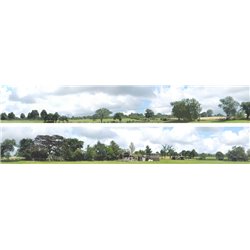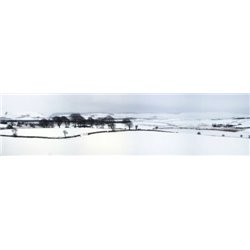Static grass puffer bottles work by manually charging model grass fibres with static electricity. When the charged...
No products
Product successfully added to your shopping cart
There are 0 items in your cart. There is 1 item in your cart.
Search Tips
What is the purpose of a backscene?
A backscene is an essential component of a model railway layout, providing a visual backdrop that enhances realism and immerses the viewer in the scene you are creating. Its primary purpose is to frame the layout, offering a sense of context and scale. By representing the environment beyond the immediate railway track—be it rolling countryside, urban skylines, or industrial landscapes—a backscene helps to ground the layout in a believable setting.
A backscene often reflects the distinctive character of local geography, architecture and weather. Whether it’s the misty hills of the Lake District, the industrial mills of the Midlands or the terraced streets of a Northern town, a well-chosen backscene sets the tone for the entire layout. It connects the individual elements of your railway—such as buildings, track, and rolling stock—with a broader narrative, making the scene feel complete and cohesive.
Another key purpose of a backscene is to create the illusion of depth. While most model railway layouts operate within limited physical space, a backscene can trick the eye into believing the landscape extends far beyond the edge of the baseboard. Techniques such as perspective, subtle shading, and carefully scaled imagery can make hills, buildings or skies appear distant, adding a sense of grandeur to even the smallest layout. This is especially important in smaller homes, where space for a model railway is often at a premium.
Backscenes also serve a practical purpose by disguising the edges of the layout. Without a backscene, the viewer’s eye is drawn to walls, furniture or other distractions in the surrounding room, breaking the illusion of the miniature world. A thoughtfully designed or painted backscene eliminates these intrusions, focusing attention solely on the railway and its setting. In addition, a backscene can help to hide wiring, shelving, or other functional but unsightly parts of the layout.
For many modellers, the process of creating a backscene is an opportunity to express artistic flair. Whether you opt for a printed backscene, hand-paint your own or use a combination of both, this element allows for creativity in capturing the mood and atmosphere of the scene. A dramatic stormy sky, for instance, could reflect the unpredictability of British weather, while a serene sunset might evoke a sense of nostalgia.
It’s also worth noting the role of lighting in enhancing a backscene. Proper lighting can bring out the subtle details of a backscene, making colours appear more vibrant and shadows more realistic. For example, simulating morning or evening light can add warmth and drama, aligning the backscene with the story of the layout. Many modellers experiment with LED strips or spotlights to achieve these effects.
In essence, a backscene is more than just a decorative element; it’s a vital part of storytelling in model railways. By thoughtfully designing or choosing a backscene that complements your layout’s theme, you can elevate your railway from a simple collection of tracks and scenery to a truly immersive miniature world. Whether you're a beginner or an experienced modeller, investing time and effort into your backscene will undoubtedly pay off in the realism and enjoyment of your layout.
Click here to receive the tips weekly in your mailbox. You can unsubscribe at any time.










